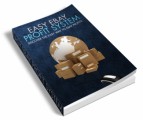Salespage Snapshot

Table of Contents
VIRAL MARKETING FOR YOUR ONLINE BUSINESSES..3
THE ELEMENTS OF A SUCCESSFUL VIRAL CAMPAIGN..3
THERE IS A FREE LUNCH, AND YOU’RE SERVING IT.3
SHARE AND SHARE ALIKE..4
SOCIAL NETWORKS4
LEARN TO USE YOUR FRIENDS AND THEIR RESOURCES.5
MAKE IT SPECIAL6
GOING VIRAL8
HOW IS “VIRAL” MARKETING UNIQUE.13
STRATEGIES..14
GIVES AWAY VALUABLE PRODUCTS OR SERVICES.14
PROVIDES FOR EFFORTLESS TRANSFER TO OTHERS.15
SCALES EASILY FROM SMALL TO VERY LARGE.15
EXPLOITS COMMON MOTIVATIONS AND BEHAVIORS.16
UTILIZES EXISTING COMMUNICATION NETWORKS.16
TAKES ADVANTAGE OF OTHERS’ RESOURCES..17
HISTORY AND VIRAL MARKETING CAMPAIGNS17
CLASSIC HISTORICAL EXAMPLES.18
OPPORTUNITIES & IDEAS..21
METHODS THAT WORK22
WINNING A PRIZE22
INFORM THEM22
FREE TRIALS23
PLAY A GAME..23
OPT IN NOT OUT24
BASIC MARKETING27
TRACKING COSTS.28
DEFINING SUCCESS.28
IMPORTANCE OF HAVING A PLAN.30
REWARD COSTS30
1. GET THEM TO SIGN UP..31
2. TRACK THEM..31
3. BOOST SALES.31
4. OFFER THE RIGHT REWARDS.31
TARGETING THE RIGHT AUDIENCE..33
SEGMENTING CUSTOMERS.33
FURTHER SEGMENTATION34
AUDIENCE SEGMENTATION DEFINED..35
GATHER SEGMENT DATA.37
TARGET PEOPLE WITH MONEY..38
Sample Content Preview
GOING VIRAL
Can you force a viral stampede? Probably not. But there are things you can do to give your marketing tactics a nudge that might just send them over the edge. Great content. This cannot be stressed enough. Without this, no matter how much effort you put into your marketing strategy, people are just not going to pass on links or eBooks or newsletters that aren’t any good. Make an effort to go the extra mile for your readers, and they’ll reward you by bringing in new customers for you. Before we get into the specific aspects of viral marketing, what it means and how to implement it, let’s spend a little time discussing the concept of traditional marketing, what it is, how to implement it.
There is nothing ‘magical’ about the concept of marketing. Simply put, marketing is any action that puts your company or its products in the minds of potential buyers of your goods and services. There is some magic however in successful marketing–a subtle blend of knowing your target audience and what will both be memorable and yet not overshadow the key elements that you need the target to remember. This, of course, takes research into what the potential sales of your goods or services might be as well as understanding possible pricing margins and the profitability that is possible for the given market; the costs of marketing can’t be such that your efforts won’t pay for themselves in the long run.
Obviously the most important part of any marketing scheme is the product itself– some things sell themselves and simply need to be introduced to the public to be recognized for the value they have. Others may be necessary and life altering, but may not be clearly understood, or the value may be undermined by availability from other resources.
The next most important aspect of a successful marketing scheme is to match the price point to a level which people will pay, and which allows for enough volume of sales to maintain future advertising and development—without being so high that it encourages others to enter competition with you.
Finding a successful price point starts with looking at your customers and the market niche, then at any competitor’s current pricing models and how customers feel about those price points. If you find you could sell for half the price of existing vendors, but the public believes the price of the goods is already fair, then entering too far below current market values may cause them to believe your product is of a lower quality or has less assurance of longevity. An excellent example of a price that is unwarranted but widely accepted is diamonds–except for the fact a diamond is one of the hardest natural substances and is as pretty as cut glass, it has very little value and is not that difficult to obtain or process. So why are they so expensive? Simply put, because the people in the business tightly control the price and help with marketing campaigns to set public acceptance of the existing price points.
Another one of the Seven Ps that is not as vital today in the Internet-driven world (but still bears thinking about) is the place—either where you will be presenting or obtaining the products you will be marketing. For most Internet-based businesses, this really boils down to the shipping model and company you will deal with to get the products to your customers. But for some, a physical retail outlet is still an important aspect of your business image and the way your company will be perceived.
There are things to consider here, too. For example, one vendor providing cheaper shipping but not enabling you to deliver without signatures can be an issue—your customers might be annoyed at having to take time off work or go to another location to obtain the product they will be anxiously awaiting. Having to arrange a schedule or fight to obtain the goods may override any excitement your successful marketing may have created. Of course, being able to physically hand someone the product in a nice bag from a retail outlet is the ideal scenario: but today most business deal at least in part with online and magazine sales. Other options may include sales at onsite locations such as exhibitions, conventions and fairs—all of which offer the same opportunities to stand out from your competitors as a retail outlet, but mean some additional planning and thinking ahead.
The “P” for Promotion is a key attribute to marketing, and especially viral marketing–it is the aspect where you pump up the public’s knowledge and understanding of your goods or services in any manner possible. Smaller budgets mean more clever marketing approaches, but some concepts you can bear in mind that should work regardless of the amount of funds available to your campaign include:
– Indirect approaches such as PR can be more effective than ‘above-the-line’ activities like advertising. Coverage in the kinds of publications your customers read is worth its weight in gold, so don’t be shy about approaching newspapers and magazines. Most journalists are keen to hear good stories, particularly if you make it easy for them by supplying photographs with a press release.
– For many new businesses, local coverage may not only be easier, it may also be more effective at generating sales.
– Know what works—look at how others in your field do it to see what kinds of promotions have been successful.
– Don’t underestimate the effectiveness of small-scale advertising in local papers, bulletin boards, and directories such as the Yellow Pages.
– Come up with a catchy slogan that customers can recall easily, and get involved in local community activities.
– Consider direct mail, telesales and the Internet advertising to win new customers.
With the proper planning and a vision of exactly what you’re trying to achieve, you should be able to hit just the right promotional mix of advertising, direct marketing and public relations. In many cases, you can learn by examining how your competitors handled early promotion concepts. Just be sure not to try and copy theirs—being unique and new is a vital element of successful marketing.
Your people can be your biggest asset or your most visible deficit–even if you’re the only employee of your company, the attitude your customers see from you at all times (whether real or just perceived) has a major impact on how your business is perceived. Ideally, you should reward existing customers in some way, and preferably a manner that your competitors do not and to provide personalized service of some kind. It can cost you between three and ten TIMES as much in advertising revenue to replace a customer who has gone to a competitor than to just keep them in the first place. So in some cases you can come out ahead in the long run just by losing a little on a few key transactions.
One way to improve your customer relations is to welcome complaints, and to provide feedback to the customers who complain, letting them know that you value the input and what actions, if any, you are going to take based on their complaints. If you are not making changes, explain why. Establishing that you understand their position but cannot address it for whatever reason is the least you can do—provided doing so doesn’t open you up to legal action!
Process refers to the methods and systems you have in place. These are what you utilize to deliver your products and track your customer satisfaction and sales as well as the costs, potential earnings and ongoing expenses per revenue generations. As far as marketing is concerned, it is perhaps the most important of all aspects of running a business. This is because with improper processes in place, you can neither understand nor extrapolate your real costs and revenue generation, and may very well be running at a long-time loss despite having profits being shown on the books currently.
Other Details- 25 Articles (TXT)
- 1 Ebook (PDF), 39 Pages
- 1 Squeeze Page (HTML)
- 2 Ecovers (PNG)
- Year Released/Circulated: 2018
- File Size: 2,199 KB
License Details:
[YES] Can sell and keep 100% of the sales.
[YES] Can edit the squeeze page.
[YES] Can be bundled into another paid package and sell at a higher price.
[YES] Can be used as a bonus to another product you are selling.
[YES] Can be sold in a Dime sale event.
[YES] Can be added into a paid membership site.
[YES] Can pass on the Master Resell Rights privilege to your customers.
[YES] Can be given away for free AGAINST an email address (lead generation)
[NO] Contents of the product can be edited, modified or altered.














